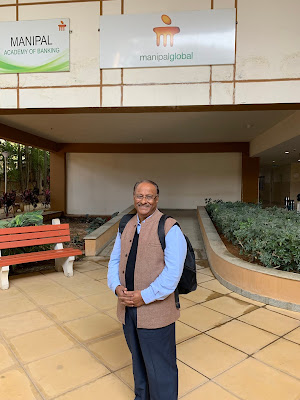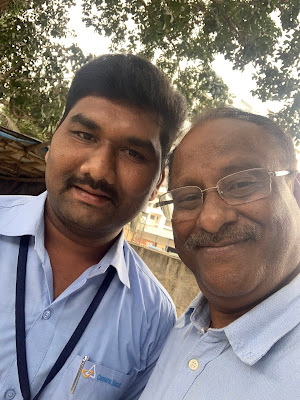Last week I witnessed the play titled
'Bengaluru Nagarathnamma', directed by Sri Nagabharana. What is common between Bharat Ratna M.S.Subbulakshmi and Bengaluru Nagarathnamma? Both of
them hailed from 'devadasi (temple dancers)' families and through their talent and dedication for music achieved greatness, but remained humble. Nagarathnamma went several steps further by fighting against the male dominated music world. She also fought for the cause of 'devadasis'. Ultimately she sacrificed all her properties for building a temple for Saint Thyagaraja at his
'samadhi' in Tiruvaiyaru. Her efforts have streamlined the organization of Thyagaraja Aradhana in its present form.
Bengaluru Nagarathnamma (1878-1952) was the daughter of Vidushi Puttalakshamma who was from the family of temple dancers of Nanjangudu temple. Although she was ordained as a 'devadasi' as per family tradition at the age of 5, her mother patronised her with education, made her an expert singer in Carnatic music and an accomplished Bharatnatyam dancer. Her patron Justice Narahari Rao took efforts to send her to Madras, where she came into contact with great musicians like
Veena Dhanammal. In spite of her social disadvantages, soon she established in Madras as a singer, dancer and a harikatha vidushi. She was the first female artist from Madras to pay Income Tax! Moreover she mobilized 'devadasis' and established the first ever Madras devasis' Sangham and became its first President.
As per directions of her Guru Bidaram Krishnappa of Mysore (who was also the Guru for Mysore T.Chowdaiah_Violin), she took up the cause of building a temple for Saint Thyagaraja at his samadhi in Tiruvaiyaru, during 1925. Moreover by selling her properties she mobilized
money for purchasing land which is now the venue for Thyagaraja Aradhana. Even after all these efforts, she was not allowed to sing with male artists at the aradhana site. Undeterred Nagarathnamma ran a parallel aradhana near the temple site, mobilizing her female students and companions. Her struggle ultimately succeeded and paved for aradhana in its present form where women artists too are given a prominent place.
Linguist Nagarathnamma took pains to edit and publish the Telugu work 'Radhika Santwanamu', originally written by Muddupalani, who too was from the 'devadasi' clan.
Kannada play on Nagarathnamma produced and music composed by Dr. P. Rama keeps you absorbed throughout by deftly narrating
her life and struggle. The entire drama narration is through a team of Carnatic music singers who double as accomplices of Nagarathanamma too. Apt Thyagaraja Kritis are used to highlight the events and pains of the play. No play-back singing here. All artists on the stage sing and dance for themselves. Melodious music to the ears throughout receives special effect through well
created scenes and dedicated acting. The entire team deserved the standing ovation it received on that day.
If you have missed the drama, don't be disappointed. The same
drama will be played on 4th Feb 2020 (Tuesday) at Chowdaiah Memorial. Moderately priced ticket bookings have already commenced on bookmyshow.com. I wish you all pleasurable time watching this great play.
'Bengaluru Nagarathnamma', directed by Sri Nagabharana. What is common between Bharat Ratna M.S.Subbulakshmi and Bengaluru Nagarathnamma? Both of
them hailed from 'devadasi (temple dancers)' families and through their talent and dedication for music achieved greatness, but remained humble. Nagarathnamma went several steps further by fighting against the male dominated music world. She also fought for the cause of 'devadasis'. Ultimately she sacrificed all her properties for building a temple for Saint Thyagaraja at his
'samadhi' in Tiruvaiyaru. Her efforts have streamlined the organization of Thyagaraja Aradhana in its present form.
Bengaluru Nagarathnamma (1878-1952) was the daughter of Vidushi Puttalakshamma who was from the family of temple dancers of Nanjangudu temple. Although she was ordained as a 'devadasi' as per family tradition at the age of 5, her mother patronised her with education, made her an expert singer in Carnatic music and an accomplished Bharatnatyam dancer. Her patron Justice Narahari Rao took efforts to send her to Madras, where she came into contact with great musicians like
Veena Dhanammal. In spite of her social disadvantages, soon she established in Madras as a singer, dancer and a harikatha vidushi. She was the first female artist from Madras to pay Income Tax! Moreover she mobilized 'devadasis' and established the first ever Madras devasis' Sangham and became its first President.
As per directions of her Guru Bidaram Krishnappa of Mysore (who was also the Guru for Mysore T.Chowdaiah_Violin), she took up the cause of building a temple for Saint Thyagaraja at his samadhi in Tiruvaiyaru, during 1925. Moreover by selling her properties she mobilized
money for purchasing land which is now the venue for Thyagaraja Aradhana. Even after all these efforts, she was not allowed to sing with male artists at the aradhana site. Undeterred Nagarathnamma ran a parallel aradhana near the temple site, mobilizing her female students and companions. Her struggle ultimately succeeded and paved for aradhana in its present form where women artists too are given a prominent place.
Linguist Nagarathnamma took pains to edit and publish the Telugu work 'Radhika Santwanamu', originally written by Muddupalani, who too was from the 'devadasi' clan.
Kannada play on Nagarathnamma produced and music composed by Dr. P. Rama keeps you absorbed throughout by deftly narrating
her life and struggle. The entire drama narration is through a team of Carnatic music singers who double as accomplices of Nagarathanamma too. Apt Thyagaraja Kritis are used to highlight the events and pains of the play. No play-back singing here. All artists on the stage sing and dance for themselves. Melodious music to the ears throughout receives special effect through well
created scenes and dedicated acting. The entire team deserved the standing ovation it received on that day.
If you have missed the drama, don't be disappointed. The same
drama will be played on 4th Feb 2020 (Tuesday) at Chowdaiah Memorial. Moderately priced ticket bookings have already commenced on bookmyshow.com. I wish you all pleasurable time watching this great play.
-0-0-0-0-0-0-0-0-








































